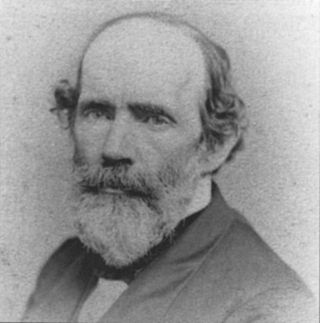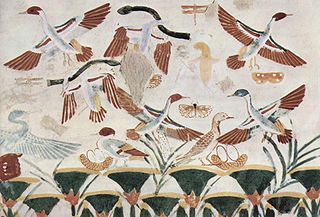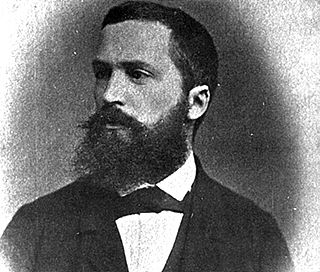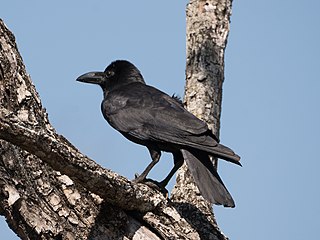
Emil Hans Willi Hennig was a German biologist and zoologist who is considered the founder of phylogenetic systematics, otherwise known as cladistics. In 1945 as a prisoner of war, Hennig began work on his theory of cladistics, which he published in German in 1950, with a substantially revised English translation published in 1966. With his works on evolution and systematics he revolutionised the view of the natural order of beings. As a taxonomist, he specialised in dipterans.

The fish crow is a species of crow associated with wetland habitats in the eastern and southeastern United States.

Estrildidae, or estrildid finches, is a family of small seed-eating passerine birds of the Old World tropics and Australasia. They comprise species commonly known as munias, mannikins, firefinches, parrotfinches and waxbills. Despite the word "finch" being included in the common names of some species, they are not closely related to birds with this name in other families, such as the Fringillidae, Emberizidae or Passerellidae.

John Cassin was an American ornithologist from Pennsylvania. He worked as curator and vice president at the Philadelphia Academy of Natural Sciences and focused on the systemic classification of the academy's extensive collection of birds. He was one of the founders of the Delaware County Institute of Science and published several books describing 194 new species of birds. Five species of North American birds, a cicada, and a mineral are named in his honor.

The following is a timeline of ornithology events:

Erwin Friedrich Theodor Stresemann was a German naturalist and ornithologist. Stresemann was an ornithologist of extensive breadth who compiled one of the first and most comprehensive accounts of avian biology of its time as part of the Handbuch der Zoologie. In the process of his studies on birds, he also produced one of the most extensive historical accounts on the development of the science of ornithology. He influenced numerous ornithologists around him and oversaw the development of ornithology in Germany as editor of the Journal für Ornithologie. He also took an interest in poetry, philosophy and linguistics. He published a monograph on the Paulohi language based on studies made during his ornithological expedition to the Indonesian island.

Friedrich Hermann Otto Finsch was a German ethnographer, naturalist and colonial explorer. He is known for a two-volume monograph on the parrots of the world which earned him a doctorate. He also wrote on the people of New Guinea and was involved in plans for German colonization in Southeast Asia. Several species of bird are named after him as also the town of Finschhafen in Morobe Province, Papua New Guinea and a crater on the Moon.

Johann Friedrich Naumann was a German scientist, engraver, and editor. He is regarded as the founder of scientific ornithology in Europe. He published The Natural History of German Birds (1820–1844) and The Eggs of German Birds (1818–1828). His father Johann Andreas Naumann (1744–1826) was a naturalist, and his brother Carl Andreas Naumann (1786–1854) was also an ornithologist.

Christian Ludwig Brehm was a German pastor and ornithologist. He was the father of the zoologist Alfred Brehm.

Ernst Johann Otto Hartert was a widely published German ornithologist.

The superb starling is a member of the starling family of birds. It was formerly known as Spreo superbus. They are long-lived birds that can live over 15 years in captivity.

The Sind sparrow is a passerine bird of the sparrow family, Passeridae, found around the Indus valley region in South Asia. Its name refers to the province of Sindh, and it is also known as the jungle, Sind jungle, or rufous-backed sparrow. Very similar to the related house sparrow, it is smaller and has distinguishing plumage features. As in the house sparrow, the male has brighter plumage than female and young birds, including black markings and a grey crown. Distinctively, the male has a chestnut stripe running down its head behind the eye, and the female has a darker head than other sparrow species. Its main vocalisations are soft chirping calls that are extended into longer songs with other sounds interspersed by breeding males. Historically, this species was thought to be very closely related to the house sparrow, but its closest evolutionary affinities may lie elsewhere. The species was discovered around 1840, but went undetected for several decades afterwards.

The Malagasy sacred ibis is a relatively large, heavily built ibis endemic to the west coast of Madagascar, and Aldabra on the Seychelles.

Henrik Grønvold was a Danish naturalist and artist, known for his illustrations of birds. Grønvold was among the last natural history illustrators to publish lithographs.

The Indian jungle crow is a species of crow found across the Indian Subcontinent south of the Himalayas. It is very common and readily distinguished from the house crow, which has a grey neck. In the past the species was treated as a subspecies of another crow species, but vocalizations and evidence from ectoparasite co-evolution and phylogenetic evidence have led to it being considered as a distinct species in modern taxonomic treatments. It differs in its voice from the large-billed crow found in the higher elevations of the Himalayas and the eastern jungle crow overlaps in the eastern part of its range. In appearance, it can be difficult to distinguish from either of these species although the plumage tends to be more uniformly glossed in purple and has a longer bill with a fine tip and a less arched culmen. The Himalayan species has a slightly wedge-shaped tail, unlike the rounded tail of the Indian jungle crow and tends to glide a lot.
Max Schönwetter (1874–1961) was a German ornithologist.

Wagler's toucanet is a species of bird in the toucan family Ramphastidae. It is endemic to southwestern Mexico.

Georg Krause was a Silesian-German oologist and bookseller from Hirschberg. He illustrated and published a book on the eggs of palearctic birds. Among his significant collections were eggs of the now-extinct Aepyornis.

















